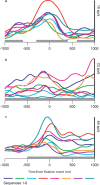Prefrontal neural correlates of memory for sequences
- PMID: 17329417
- PMCID: PMC6673483
- DOI: 10.1523/JNEUROSCI.4483-06.2007
Prefrontal neural correlates of memory for sequences
Abstract
The sequence of actions appropriate to solve a problem often needs to be discovered by trial and error and recalled in the future when faced with the same problem. Here, we show that when monkeys had to discover and then remember a sequence of decisions across trials, ensembles of prefrontal cortex neurons reflected the sequence of decisions the animal would make throughout the interval between trials. This signal could reflect either an explicit memory process or a sequence-planning process that begins far in advance of the actual sequence execution. This finding extended to error trials such that, when the neural activity during the intertrial interval specified the wrong sequence, the animal also attempted to execute an incorrect sequence. More specifically, we used a decoding analysis to predict the sequence the monkey was planning to execute at the end of the fore-period, just before sequence execution. When this analysis was applied to error trials, we were able to predict where in the sequence the error would occur, up to three movements into the future. This suggests that prefrontal neural activity can retain information about sequences between trials, and that regardless of whether information is remembered correctly or incorrectly, the prefrontal activity veridically reflects the animal's action plan.
Figures






References
-
- Asaad WF, Rainer G, Miller EK. Neural activity in the primate prefrontal cortex during associative learning. Neuron. 1998;21:1399–1407. - PubMed
-
- Asaad WF, Rainer G, Miller EK. Task-specific neural activity in the primate prefrontal cortex. J Neurophysiol. 2000;84:451–459. - PubMed
-
- Averbeck BB, Lee D. Effects of noise correlations on information encoding and decoding. J Neurophysiol. 2006;95:3633–3644. - PubMed
-
- Averbeck BB, Chafee MV, Crowe DA, Georgopoulos AP. Neural activity in prefrontal cortex during copying geometrical shapes I. Single cells encode shape, sequence, and metric parameters. Exp Brain Res. 2003a;150:127–141. - PubMed
Publication types
MeSH terms
Grants and funding
LinkOut - more resources
Full Text Sources
